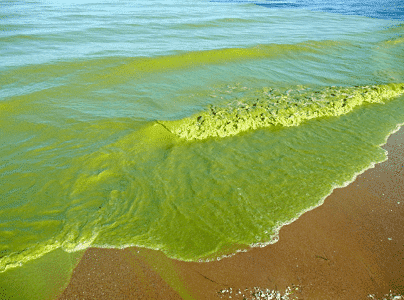
 Researchers have discovered another way that algae blooms are becoming a worldwide environmental disaster: they cause embryonic heart failure in fish species.
Researchers have discovered another way that algae blooms are becoming a worldwide environmental disaster: they cause embryonic heart failure in fish species.
Scientists have been putting more effort into understanding the effects of cyanobacteria (or blue-green algae) blooms on ecological health. Human agricultural practices which feed the growth of fresh-water algae are to blame for the growing phenomenon, along with climate change which has raised temperatures in lakes and water systems and allowed the cyanobacteria to flourish.
Major water systems like North America’s Lake Erie have been plagued by blue-green algae, which causes water systems to become ecological dead zones, preventing light from going below the surface and keeping oxygen from reaching organisms living within the water body. For humans and other animals, algae blooms leave water undrinkable.
Last week, Sudbury, Ontario, health officials released a warning about blue-green algal blooms which have been spotted in nearby McFarlane Lake. “The algae toxins can irritate a person’s skin and, if ingested, cause diarrhea and vomiting. If a person ingests high levels of toxin, they could suffer liver and nervous system damage,” reads the Sudbury and District Health Unit advisory.
But the harm caused by cyanobacteria blooms to fish has been less clearly understood. Research has shown that gill damage occurs due to the high water pH produced by algae blooms, along with higher levels of ammonia and toxic intake which causes liver stress. But the new study advances the science by showing that fish at the embryonic stage can be affected, which in turn can seriously impact the survival of a species.
Researchers from Yunnan University in China and the University of Windsor in Ontario studied the impact of cyanobacterial blooms on the Sinocyclocheilus grahami species of fish, also known as the golden-line barbel, which used to flourish in Dianchi Lake in southern China but has since been driven to the brink of extinction due to industrial pollution.
“Cyanobacteria blooms have become an increasingly serious problem in Dianchi Lake since the 1980s, and we hypothesize that they may be responsible for the disappearance of important fishes, including S. grahami, as well as its failed re-introduction into the lake,” say the study’s authors.
The researchers took adult S. grahami and exposed them to varying levels of cyanobacteria and its toxic byproducts, finding that fertilization and hatching rates decreased while malformation and mortality rates increased as the concentration of blue-green algae went up. Sperm quality and motility declined with increasing concentrations, as well.
Malformations at the embryonic stage were found to be significant, showing impairments in yolk sac formation, thoracic deformity, spinal curvature and heart failure due to deformities.
The researchers say the evidence points towards the algae blooms as being central to the fish declines in Dianchi Lake, an ecosystem which has seen major investment by the Chinese government over recent decades in clean up and restoration.
“Successful survival of offspring is a key requirement of population establishment, persistence or recovery,” say the researchers. “The failure of embryo development when exposed to [cyanobacteria] could be a major obstacle to successful reintroduction of this fish species in Dianchi Lake.”
The new research is published in the journal Aquatic Toxicology.
Leave a Reply
You must be logged in to post a comment.



 Share
Share Tweet
Tweet Share
Share




Comment